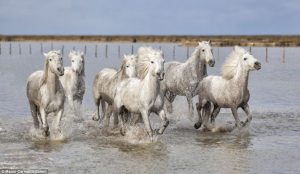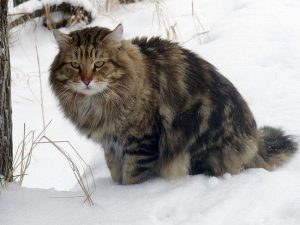This text was once a letter sent to a breeder friend. I would like to share these thoughts about the responsibility of choosing to work with a natural breed such as Siberians.
Dear friend, I am wondering if you ever heard about “Camargue” horses?
The Camargue is a breed of small rustic horse in a grey dress, from the homonymous region, south of France in the Rhône delta, on the Gard and Bouches-du-Rhône . This horse traditionally lives in freedom in its original marsh and its genealogy remains mysterious, although it is considered one of the oldest breeds in the world.
Mentioned from Roman antiquity and compared to horses we see on Lascaux paintings: The French palaeontologist Vera Eisenmann believes that this race could be «a relic of prehistoric wild horses. ».
Camargue horses live mostly in freedom and sometimes are used by men with working purposes but most time released back at the “marais” after the work is done.
These horses developed certain characteristics along the years to live and thrive on the Camargue marais: Its stature and morphology, its particularly resistant hooves adapted for life at the marais.
Camargue people are very proud of their small, strong saddle horse and all attempts of mixing the breed with the purpose of making it “taller” were discouraged and discontinued by “Les Haras nationaux” and Camargue horses are one of the symbols of the region.
The only colouring accepted for Camargue horses is GREY because it is the original coloring of the horses in their natural state and habitat.
I am certain there might have been crosses here and there now and then: farmers who owned other breeds, also sorcerer apprentices who wanted to see the result of a certain match and even accidental mating with other breeds that were brought into the area by men. I am sure we can find in the region that odd brown Camargue looking like a horse, most likely in a stable, result from one of those eventual matings.
With human influence and sometimes even under the influence of “Mother Nature” with spontaneous mutations, several changes and possibilities become then possible (i.e. albino animals, alopecia etc.)
It doesn’t mean that these changes should be encouraged, cultivated or bred, especially if this mutation expresses a form of “handicap”.
The definition of “natural breed” or “native breed”: a population of native animals that are the product of a spontaneous selection in isolated areas, bearing common phenotype.
Breeding horses is a complex affair, and working with a NATURAL breed is even more demanding. Camargue horses could be wiped off the map very easily! It is very important to watch over their genetic pool and preserve their natural characteristics. Preserve their genotype and phenotype.
We all appreciate equine beauty and grace, but breeding in my opinion is not only about aesthetic factors like colors and patterns. However, colours and patterns are the least important points in a serious breeding program.
A black and white spotted Camargue? An Appaloosa-looking Camargue?
I am not a horse expert, but the Appaloosa pattern is a complex mix of breeds and colour patterns.
Obviously, Appaloosa horse genes (and pattern) are not from this French area of the globe.
Considering only looks, some people might think this mix would look lovely, but to obtain such horses, sacrifices would have to be made. We are talking here about sacrificing the Camargue genetic pool. Would it be worth it, especially when other breeds already have similar looks (Appaloosa)?
Imagine this: Appaloosa horses are brought into Camargue and left wandering in the land and farms. We notice some spotted little ponies around.
Less educated or careless (irresponsible) Camargue farmers/breeders might think making more of these ponies is a great idea, especially if there is demand and other countries are ready to pay good money for them! Let’s create Carmagloosa and try to have it accepted as a Camargue horse, a variety of Camargue horses, or perhaps a sister breed.
Responsibility and a scientific approach are needed to work with a natural breed. Do you want to see real Camargue horses walking about in the marais in 20 years? Ensure the generations can also appreciate its grey beauty galloping on Camargue. If your answer is “yes”, then the genetic pool must be preserved. Otherwise, you will leave for the generations to come a horse that is “kind of what” used to be a Camargue horse”.
The Camargue is a “Pearl”, a national treasure in France, as the Siberian cat should have been seen and treated by Russians as a national treasure. Unfortunately, this is far from being what happened (happens) in Russia.
Talking about preservation and natural” treasure”, the Haras Nationaux de France protects the Camarge; mixes with Camargue horses aren’t authorized, and ponies are registered with a “Manade number” that controls even the group of horses that precise Pony is coming from.
The point is that horses are horses (cats are cats). If nothing is changed by human hand, Camargue horses will continue to be grey and sturdy for long years ahead.
Talking about humanity is a different matter. It is a mistake to make a parallel between men and animals. Men have feelings, dreams, and love; we can make our own choices; we travel; we move.
Animals that belong to certain regions in the globe, developed certain characteristics because of the area and its way of life and we can even talk about the ecosystem they evolved in,will remain unchanged if there are no major external interference.
If a man decides to breed and select using these individuals (for any reason), why to do so if there is no intent to preserve the livestock and their gene pool A tom cat (or a Camargue stud) will be happy mating with any healthy female no matter what colour, pattern or shape It is our role to select the right matches, right individuals in order to preserve the breed and its gene pool.
Preserving natural breeds is a bit like preserving the gifts nature crafted for us in these specific, sometimes remote areas of the globe and it also means preserving the cultural background of people who live in these areas.
I have several Russian friends, some not even related to cat breeding, saying that the Siberians they see now have nothing in common with the cats they used to see and grew up with It does make me feel sad that the Siberian cat was somehow lost in translation in their own birth country.
Daniela Barros.

